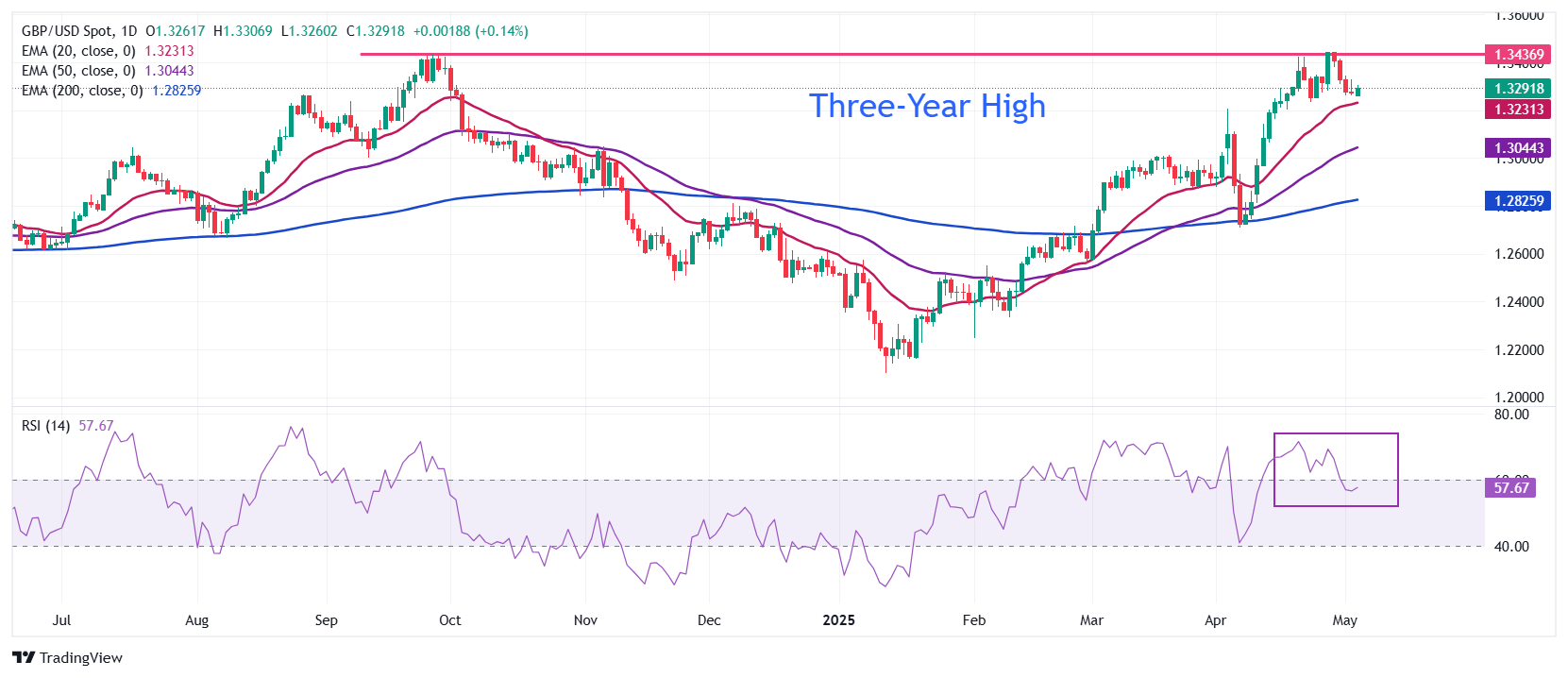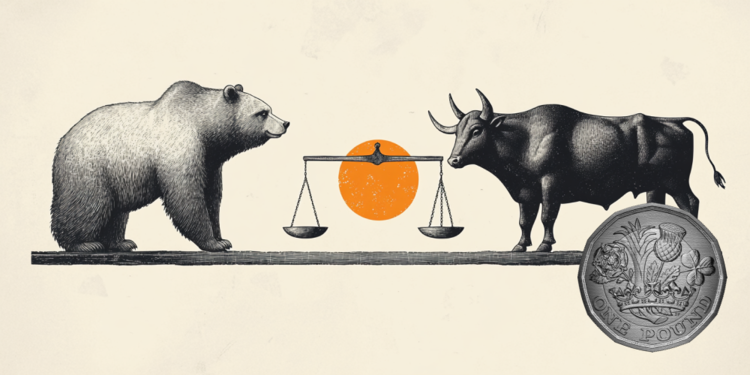- The Pound Sterling ticks higher against the US Dollar at the start of Fed-BoE monetary policy announcements on Wednesday and Thursday.
- The Fed is expected to leave interest rates steady, while the BoE is almost certain to cut borrowing costs by 25 bps.
- US-China trade uncertainty is expected to persist for longer.
The Pound Sterling (GBP) exhibits a mixed performance in a holiday-thinned trade as the United Kingdom (UK) markets are closed at the start of the week on account of Early May. Investors brace for significant volatility in the British currency this week as the Bank of England (BoE) is scheduled to announce the interest rate decision on Thursday.
According to analysts at Bank of America (BofA), the BoE will cut borrowing rates by 25 basis points (bps) to 4.25%, with a majority vote of 8-1. The BofA expects that Monetary Policy Committee (MPC) member Swati Dhingra to vote for a larger-than-usual interest rate reduction of 50 bps.
The BofA also believes that potential economic risks in the face of Trump’s tariffs, improving domestic inflation, and declining energy costs justify the rate reduction. For the remaining year, the bank has anticipated that the BoE could reduce interest rates twice more, excluding the rate cut on Thursday.
On the global front, persistent uncertainty over US-China trade relations will keep the British currency and UK assets under pressure. The comments from US President Trump over the weekend indicated that the Sino-US trade war will not resolve in the near term. Trump said on Sunday that he is not going to speak with Chinese President Xi Jinping this week, but signaled that higher tariffs on imports from Beijing will be reduced ahead. “At some point, I’m going to lower them, because otherwise, you could never do business with them, and they want to do business very much,” he said.
British Pound PRICE Today
The table below shows the percentage change of British Pound (GBP) against listed major currencies today. British Pound was the strongest against the US Dollar.
| USD | EUR | GBP | JPY | CAD | AUD | NZD | CHF | |
|---|---|---|---|---|---|---|---|---|
| USD | -0.17% | -0.46% | -0.59% | -0.04% | -0.56% | -0.65% | -0.36% | |
| EUR | 0.17% | -0.02% | -0.16% | 0.39% | -0.13% | -0.21% | 0.08% | |
| GBP | 0.46% | 0.02% | -0.36% | 0.41% | -0.09% | -0.20% | 0.10% | |
| JPY | 0.59% | 0.16% | 0.36% | 0.56% | 0.04% | 0.02% | 0.34% | |
| CAD | 0.04% | -0.39% | -0.41% | -0.56% | -0.82% | -0.61% | -0.32% | |
| AUD | 0.56% | 0.13% | 0.09% | -0.04% | 0.82% | -0.09% | 0.21% | |
| NZD | 0.65% | 0.21% | 0.20% | -0.02% | 0.61% | 0.09% | 0.28% | |
| CHF | 0.36% | -0.08% | -0.10% | -0.34% | 0.32% | -0.21% | -0.28% |
The heat map shows percentage changes of major currencies against each other. The base currency is picked from the left column, while the quote currency is picked from the top row. For example, if you pick the British Pound from the left column and move along the horizontal line to the US Dollar, the percentage change displayed in the box will represent GBP (base)/USD (quote).
Daily digest market movers: Pound Sterling rises against US Dollar
- The Pound Sterling ticks up to near 1.3285 against the US Dollar (USD) during European trading hours on Monday, rebounding from a fresh weekly low around 1.3260 earlier in the day. The GBP/USD pair edges higher as the US Dollar (USD) continues to face pressure ahead of the Federal Reserve’s (Fed) monetary policy decision, which will be announced on Wednesday.
- According to the CME FedWatch tool, markets almost fully price in that the central bank will keep interest rates steady in the range of 4.25%-4.50%. Therefore, the major trigger for the US Dollar will be monetary policy guidance by the Fed and its Chairman, Jerome Powell, for the remainder of the year.
- Fed officials have stated that monetary policy adjustments would become appropriate only if they see cracks in the labor market and the economy. However, recent United States (US) Nonfarm Payrolls data for April showed a better-than-expected job growth trend despite the tariff policy by President Donald Trump. Additionally, Q1 Gross Domestic Product (GDP) data was not as bad as it appeared at first glance, as the contraction was due to a robust increase in imports.
- Another key limiting factor for the Fed to lower interest rates is elevated consumer inflation expectations. Business owners are hiking selling prices to offset the impact of rising input costs amid higher import duties, fuelling price pressures on the economy.
- Meanwhile, US President Trump has insisted that the Fed should bring interest rates down. “Gasoline just broke $1.98 a Gallon, the lowest in years, groceries (and eggs!) down, energy down, mortgage rates down, employment strong, and much more good news, as Billions of Dollars pour in from Tariffs. Just like I said, and we’re only in a transition stage, just getting started!!! Consumers have been waiting for years to see pricing come down. no inflation, the Fed should lower its rate!!!” Trump wrote in a post on Truth.Social on Friday.
- Trump has also pushed back fears of assaulting the Fed’s autonomy by clarifying that he will not fire Chairman Powell. “No, no, no. That was a total – why would I do that? I get to replace the person in another short period of time,” Trump said in an interview with NBC News on Sunday, Reuters reported.
Technical Analysis: Pound Sterling holds all short-to-long-term EMAs

The Pound Sterling trades slightly above the weekly low of 1.3260 against the US Dollar on Monday. The pair corrected last week from the three-year high of 1.3445. The overall outlook remains bullish as all short-to-long Exponential Moving Averages (EMAs) are sloping higher.
The 14-day Relative Strength Index (RSI) strives to return above 60.00. A fresh bullish momentum would trigger if the RSI manages to do so.
On the upside, the three-year high of 1.3445 will be a key hurdle for the pair. Looking down, the April 3 high around 1.3200 will act as a major support area.
Economic Indicator
BoE Interest Rate Decision
The Bank of England (BoE) announces its interest rate decision at the end of its eight scheduled meetings per year. If the BoE is hawkish about the inflationary outlook of the economy and raises interest rates it is usually bullish for the Pound Sterling (GBP). Likewise, if the BoE adopts a dovish view on the UK economy and keeps interest rates unchanged, or cuts them, it is seen as bearish for GBP.
Read more.
Next release:
Thu May 08, 2025 11:00
Frequency:
Irregular
Consensus:
4.25%
Previous:
4.5%
Source:
Bank of England

